Sound analysis of broilers to be explored to boost health and welfare

Researchers are to look at sound analysis of broiler chickens to see what they can tell about the health, welfare and productivity of birds during their lifetime.
The project, coordinated at the University of Bristol’s Department of Agriculture, Veterinary and Food Science, comes at a time when there is growing belief that vocalisation sounds in broilers reared under intensive farm conditions may have the potential to be used as a tool to improve health and welfare.
Vocalisations by chicks
Precision livestock farming is developing management tools aimed at continuous automatic monitoring of animal welfare, health, environmental impact and production in real time. Audio analysis, and decision making informed by audio information and prediction and avoidance of health, welfare and disease impacts through use of automated measures may have the potential to have positive effects on animal health and welfare in poultry farming systems.
Led by Dr Andy Butterworth, the project’s objectives are the identification and characterisation of vocalisations by chicks, using automated audio assessment tools, during early life, under normal farm conditions. The project will also examine the possible links between specific individual sounds and social behaviours, and the characterisation of possible vocalisation changes in terms of frequency and type of sound as the birds age.
In addition, the study – which begins in September – will look at whether there are any links between voice changes, frequency and type of sounds with alterations in house environmental factors.
Research
The most recent research in this area, “Sound analysis to model weight of broiler chicken” published in Poultry Science in 2017, recorded sounds and body weight in an intensive broiler farm during 5 production cycles. For each cycle, the peak frequencies of the chicken sounds were used to estimate the weight and they were compared with the observed weight of the birds. No significant difference was shown between expected and observed weights along the entire production cycles. The identified model used to predict the weight as a function of the peak frequency confirmed that bird weight might be predicted by the frequency analysis of the sounds emitted at farm level.
Join 31,000+ subscribers
Subscribe to our newsletter to stay updated about all the need-to-know content in the poultry sector, three times a week. Beheer
Beheer








 WP Admin
WP Admin  Bewerk bericht
Bewerk bericht